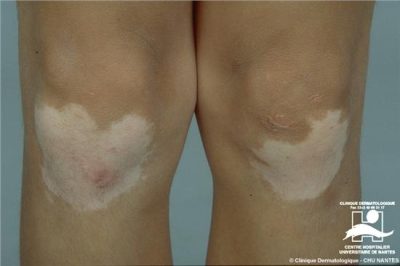SERVICES
- Allergy Screening
- Chemical Peels
- Dermapen
- Facial Skin Analysis
- FreshEyes
- Hyperhidrosis (Excessive Sweating)
- Hair Loss Treatment
- Laser Clinic
- Liquid Facelift
- Keloid Treatments
- Medical Facials
- Medical Treatments
- Mole Mapping
- Photodynamic Therapy (PDT)
- Skincare Advice
- Pigmentation Treatment
- Surgical Procedures
- Ultraviolet Phototherapy
USEFUL LINKS
What is Vitiligo?
 Vitiligo is a condition in which areas of skin lose their normal pigment and so become white. It is common, and affects about 1% of the world’s population. It can start at any age, but in about half it does so before 20 years of age. Its course is unpredictable, but it tends to progress slowly, with periods of stability often lasting several years. The pigment may return in some patients, but this cannot be guaranteed, and seldom does so completely.
Vitiligo is a condition in which areas of skin lose their normal pigment and so become white. It is common, and affects about 1% of the world’s population. It can start at any age, but in about half it does so before 20 years of age. Its course is unpredictable, but it tends to progress slowly, with periods of stability often lasting several years. The pigment may return in some patients, but this cannot be guaranteed, and seldom does so completely.
What causes vitiligo?
The pigment that gives your skin its normal colour is melanin, which is made by cells known as melanocytes. In patches of vitiligo the melanocytes are absent, and the reason for this is not fully understood.
However, vitiligo is considered to be an ‘autoimmune’ condition in which the body’s own immune system rejects some of its own tissues (melanocytes in the case of vitiligo). Consistent with this, thyroid disease and other autoimmune conditions are more common in individuals with vitiligo.
It affects men and women of all races equally, but is most obvious in people with dark skins. It is not infectious. There is no medical evidence of any link between diet and vitiligo.
Is vitiligo hereditary?
Yes, vitiligo has a genetic basis, although only about a fifth of those with vitiligo know of someone in their family who also has it. The exact type of inheritance has not yet been worked out. If you have vitiligo, it does not necessarily follow that your children will develop it too.
What are the symptoms of vitiligo?
These fall into two groups:
- Natural sunlight causes sunburn of the pale areas very easily.
- Those affected by vitiligo may find it a cosmetic embarrassment, especially when it affects normally exposed skin. Vitiligo will stand out more obviously when the surrounding skin is tanned or in naturally dark-skinned individuals.
Vitiligo is not an itchy or sore condition.
What does vitiligo look like?
Vitiligo consists of skin that totally lacks the normal melanin pigmentation, and is thus completely white. It is usually symmetrical. The skin otherwise feels entirely normal. The most common sites for vitiligo are the hands and face, around body openings (the eyes, nostrils, mouth, umbilicus and genital regions), and within body folds such as the underarms and groin. When hair-bearing skin is involved, the hair may lose its pigment.
Repigmentation often commences around hair follicles, initially giving a rather speckled appearance.
How will vitiligo be diagnosed?
The diagnosis is usually easy to make by its appearance. Occasionally, examination under an ultraviolet lamp is helpful, especially in light-skinned people. Once the diagnosis of vitiligo has been made, your doctor may want to take a blood sample to check for thyroid disease and for other autoimmune conditions.
Can vitiligo be cured?
At present, there is not a guaranteed cure for vitiligo, although treatment may be helpful.
How can vitiligo be treated?
There are a number of treatment options that can be discussed with your GP or dermatologist. Often no treatment may be required other than good sun protection, especially in pale-skinned individuals.
- Sunscreens Areas of vitiligo will burn easily in the sun. The use of a sunscreen with a sun protection factor (SPF) of 30 or higher helps to protect skin affected by vitiligo, and also, when applied more widely, reduces the contrast between the areas of vitiligo and the surrounding normal skin. Other standard sun protection measures, such as appropriate clothing and sun avoidance, should also be employed.
- Topical corticosteroids The application of a potent or very potent corticosteroid cream or ointment to areas of vitiligo may restore some pigment, but side effects, such as thinning of the skin and stretch marks, are a real risk with continued use.
- Other topical preparations Other types of anti-inflammatory creams and ointments, such as calcineurin inhibitors (tacrolimus and pimecrolimus) and vitamin D analogues, may also restore pigment in some patients.
- Phototherapy This involves exposing affected skin to ultraviolet light, despite the fact that skin which has lost its pigment is much more susceptible to the damaging effects of ultraviolet radiation. Phototherapy may be helpful in a proportion of individuals with vitiligo. However, treatment needs to be very prolonged (lasting at least several months), full repigmentation is unusual and cosmetically sensitive areas such as the fingertips and the skin around the lips are less likely to improve.
- Surgical treatment This process involves transplanting small islands of normal skin into the areas of vitiligo and appears to work best in cosmetically sensitive areas. These techniques are still being developed and are not yet in general use.
- Removing the remaining pigment If vitiligo has spread very widely (more than 50% of the body) or involves large areas of the face or hands, it may very rarely be reasonable to consider removing the small amounts of pigment that are left using a bleaching chemical (hydroquinone). This results in total depigmentation, and the emotional, social and medical implications must be carefully discussed before this treatment is used.
- Psychological treatments Coping mechanisms may be useful in selected cases of vitiligo.
- Cosmetic camouflage Advice from experts about cosmetic camouflage is now widely available. There are good quality camouflage cosmetics in a range of colours that are hard to rub off, and can be waterproof. Your GP or dermatologist will arrange instruction in this technique, if you so wish. Fake suntans can sometimes effectively disguise vitiligo.
Self care (What can I do?)
- Be careful in the sun; use sunscreens and protective clothing.
- Use cosmetics if you want to.
- Bear in mind that vitiligo is a cosmetic issue and does not affect the real you.
Patient Testimonials
EXCELLENTTrustindex verifies that the original source of the review is Google. From my first visit with Dr Jhetam I knew I would go back. He is compassionate , friendly and has an interaction which made you feel comfortable. This is very important in any doctor because our relationship with our doctor is very intimate.Posted onTrustindex verifies that the original source of the review is Google. Dr Jhetman is truly one of a kind. Anyone who is fortunate enough to be in his care can so grateful. Academic, informative and reassuring. It’s hard to find a doctor who has this combination of skills these days. He dealt with my Melonoma concerns with swift and professional care. And his staff are equally as competent and caring. I cannot commend Dr Jhetman and his staff enough on true patient care. Thank you!Posted onTrustindex verifies that the original source of the review is Google. I was absolutely satisfied with my experience with Dr Jhetham & his winning team. Keep up the good work.Posted onTrustindex verifies that the original source of the review is Google. Best skin doctor..Dr Jetham prescribed the best products that have brought so much of a glow to my skin..being a transplant patient and so much happening to my skin just 4 visits to him and my face is back to it's radiance ..I hightly reccomend Dr Jetham ...you won't go wrong..Posted onTrustindex verifies that the original source of the review is Google. Dr. Imraan Jhetam and his team provided exceptional care, showcasing professionalism and compassion in every interaction. Dr. Jhetam took the time to thoroughly explain everything, addressing each of my concerns with empathy and understanding. My experience with him was truly wonderful, and I highly appreciate his dedication to patient care.Verified by TrustindexTrustindex verified badge is the Universal Symbol of Trust. Only the greatest companies can get the verified badge who has a review score above 4.5, based on customer reviews over the past 12 months. Read more



